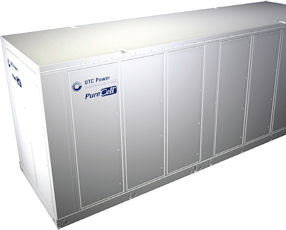The De Soto Avenue campus of Pratt & Whitney Rocketdyne is now getting some of its electricity from a fuel cell – an exotic $3 million power supply fueled by natural gas. The fuel cell was developed by the power generation division of United Technologies Corp., the Hartford, Conn., parent of Rocketdyne. The 400 kilowatt device tucked away in a back area of the 50-acre facility is about the size of a rectangular shipping container. “This is just one step we’ve taken to lower our environmental footprint,” said Eric Hofman, senior manager of California facilities and plant operations. Rocketdyne is the first Southern California location to install a United Technologies fuel cell. CBS Studios Center in Studio City will be installing three of them in the next few months. Both projects received rebates from the California Self-Generation Incentive Program. Together with federal incentives, the fuel cell’s price tag can be cut by 60 percent. The United Technologies fuel cell is powered by natural gas that is converted into hydrogen gas. The hydrogen is then combined with air within the cell and creates an electrochemical process to produce energy. There is no combustion so carbon emissions are eliminated. The fuel cell also creates waste heat that Rocketdyne uses in a building that includes offices, warehouse space, manufacturing, assembly, and shipping and receiving. “We can shut down our boilers as a result,” said Ron Sherer, manager of environment, health and safety for Rockedyne. The process that brought the fuel cell began about 16 months ago. A companywide committee also considered solar installations and microturbines to bring green energy to the campus but went with the fuel cell because of the cost savings, reliability and practicality, Hofman said. Unlike solar panels, the fuel cell can run around the clock. “It is not dependent on the sun shining on it,” Sherer said. Rocketdyne has cut water consumption by 35 percent, power consumption by 31 percent and waste by 35 percent as part of its initiative to reduce environmental impacts. – Mark R. Madler
